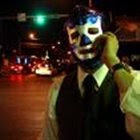 There are better silent horror and fantasy films out there, but perhaps no flick in the whole Silent Scream series is as reliably fun as Harry O. Hoyt's 1925 classic The Lost World. Often billed as the first feature film to utilize stop-motion animation, The Lost World is the primal "giant beast" movie. Often there's a desire on the part of silent film fans to claim direct influence wherever a pattern of prior art can be established. If, for example, there's a movie featuring a vampish test-tube grown woman (Alrune: Unholy Love, 1928), then silent film fans eager to prove the relevance of their interests then silent film fans will promote it as the "obvious" source of any artificial femme – from she-Terminators to Cherry 2000. I think, however, influence of The Lost World can be theorized without recourse to leaps of faith. Films like King Kong (both the original and the remake) and the first two pics from the Jurassic Park franchise overtly lift or allude to scenes from the 1925 film. The Lost World's technological creativity, strong story, and enduring ability to please viewers by appealing to a child-like sense of wonder all make the flick a creative well-spring which modern filmmaker continue to tap.
There are better silent horror and fantasy films out there, but perhaps no flick in the whole Silent Scream series is as reliably fun as Harry O. Hoyt's 1925 classic The Lost World. Often billed as the first feature film to utilize stop-motion animation, The Lost World is the primal "giant beast" movie. Often there's a desire on the part of silent film fans to claim direct influence wherever a pattern of prior art can be established. If, for example, there's a movie featuring a vampish test-tube grown woman (Alrune: Unholy Love, 1928), then silent film fans eager to prove the relevance of their interests then silent film fans will promote it as the "obvious" source of any artificial femme – from she-Terminators to Cherry 2000. I think, however, influence of The Lost World can be theorized without recourse to leaps of faith. Films like King Kong (both the original and the remake) and the first two pics from the Jurassic Park franchise overtly lift or allude to scenes from the 1925 film. The Lost World's technological creativity, strong story, and enduring ability to please viewers by appealing to a child-like sense of wonder all make the flick a creative well-spring which modern filmmaker continue to tap.The Lost World is based on Arthur Conan Doyle's novel of the same name. Doyle's popular work has been adapted for the screen and television so often that it has become nearly archetypal and it is hard to imagine that anybody reading this needs a summary. Still, in keeping with well-established Interbloggy traditions, we at ANTSS shall provide one. The film opens with the public disgrace of one Professor Challenger of London (played by Wallace Berry: vet of more than 200 silent and talkie flicks, include his Oscar winning turn in heartbreaking The Champ). Challenger claims to have discovered a geographically isolated plateau that still supports prehistoric life. The idea is, of course, absurd. The Royal Society has mucho LOLs at Challenger's expense and the embittered scientist mounts an expedition to the plateau. Joining him is a cast of reporters, hunters, generic guides, and a few damsels-to-be-distressed. Challenger's reports not only prove true, but he manages to capture a brontosaurus and bring it back to London. As these beasts always do, the irate dino breaks free and rampages through the town.
Discussion of the effects – a wealth of excellent stop-motion animations – often dominates talk of the look of the film, but there's a lot here to like. Though the director, Hoyt, would remain an otherwise unremarkable journeyman sort, he manages a large cast and some truly excellent sets with real skill. He has an especially fine grasp of deep compositions, whether he's combining plate shots with live actors in the foreground or simply filming his leads in a quiet Victorian study. The George Eastman House restoration is remarkably clean, with excellent tint-coloring works beautifully with the story.
Admittedly, The Lost World is lighter fare than much of material in the Silent Scream Series. You won't find the rotting hothouse sensuality, the paranoid madness, or the grim atmosphere of more "artistic" horror flicks here. But if The Lost World's aims are simpler, they are no less noble. There's an innocence to the flick that isn't a product of technological primitiveness or ideological simple-mindedness. There's a magical joy – and it is the essential pleasure of all fantastic cinema – in making the impossible possible, of providing visual evidence for what could only exist in dreams.
Perhaps this is why, despite its lack of gravitas and its lack of high art stylishness (this may be one of the few films we'll be profiling here that owes nothing whatsoever to German Expressionism), The Lost World continues to inspire filmmakers. Long after the angular sets of Caligari have gone the way of the kinetoscope and Nosferatu has become a of source of in-references for horror buffs, there's something irresistible about the image of a dinosaur stomping through the streets of London: an impossible monster rendered in all its awkward and life-like glory can't help but bring a smile to your face.
I recommend The Lost World to anybody who still has the feeling that there's something inexpressibly great about the medium of film.
SCREAMIN' FUN FACT: The Lost World was the first in-flight movie ever. In April of 1925, passengers on Imperial Airways' London to Paris flight were screened the flick for their in-flight entertainment.

No comments:
Post a Comment